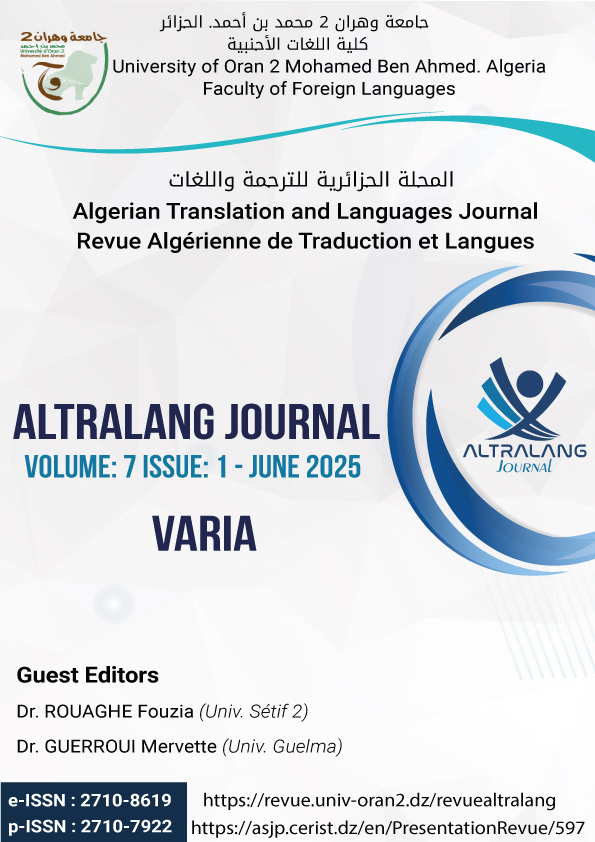Exploring the Interpretation of Idiomatic Verbal Phrases in Arabic: A Comparative Study of English and French-Speaking Advanced Learners
Main Article Content
Abstract
This study explores how proficient Arabic learners, whose first language is English or French, understand idiomatic verbal expressions by moving beyond traditional grammatical rules. The research examines the use of figurative interpretation to comprehend these idiomatic expressions. It evaluates how learners' linguistic background impacts their ability to differentiate between literal and figurative meanings. An experimental approach was used to compare the performance of English and French-speaking learners, employing quantitative and qualitative data analysis tools like SPSS and NVivo.
Article Details

This work is licensed under a Creative Commons Attribution 4.0 International License.
LICENSE: This work is licensed under a Creative Commons CC BY 4.0 license
References
• Amraoui, F. (2019). Language interference in learning Arabic as a second language (L2): Descriptive and analytical study. Revue de l'Administration de l'Éducation, (8–9), 123–140.
• Aydın, B. (2019). Cognitive processing of second language idiom comprehension: A comparative study. Journal of Language and Linguistic Studies, 15(1), 307–325. https://doi.org/10.17263/jlls.547750
• Bazeley, P., & Jackson, K. (2013). Qualitative data analysis with NVivo. Sage Publications.
• Beréndi, M., Csábi, S., & Kövecses, Z. (2008). Polysemy and conceptual metaphors in vocabulary teaching: An empirical investigation.
• Cieślicka, A. B. (2015). Idiom acquisition and processing by second/foreign language learners. In R. R. Heredia & A. B. Cieślicka (Eds.), Bilingual figurative language processing (pp. 208–244). Cambridge University Press. https://doi.org/10.1017/cbo9781139342100.012
• Coxhead, A. (2024). Understanding teachers' perceptions of incidental vocabulary learning. In A. Pellicer-Sánchez (Ed.), Researching incidental vocabulary learning in a second language (pp. xx–xx). [Publisher if known].
• Creswell, J. W. (2014). Research design: Qualitative, quantitative, and mixed methods approaches (4th ed.). Sage Publications.
• Field, A. (2013). Discovering statistics using IBM SPSS Statistics (4th ed.). Sage Publications.
• Ganji, M. (2011). The best way to teach phrasal verbs is through translation, sentential contextualisation, or metaphorical conceptualisation. Theory and Practice in Language Studies, 1(11), 1497–1506. https://doi.org/10.4304/tpls.1.11.1497-1506
• Gibbs, R. W. (1994). The poetics of mind: Figurative thought, language, and understanding. Cambridge University Press.
• Jarvis, S. (2008). Crosslinguistic influence in language and cognition. Routledge.
• Kövecses, Z. (2015). Where metaphors come from: Reconsidering context in metaphor. Oxford University Press.
• Lakoff, G., & Johnson, M. (1980). Metaphors we live by. University of Chicago Press.
• Samani, E. R. (2012). The effect of conceptual metaphors on learning idioms by L2 learners. International Journal of English Linguistics, 2(1), 249. https://doi.org/10.5539/ijel.v2n1p249
• Tabachnick, B. G., & Fidell, L. S. (2013). Using multivariate statistics (6th ed.). Pearson.
• Veliz, L., & Smith, S. (2021). On the teachability of figurative language: Teachers’ perceptions of the role of metaphor in English language teaching in Chile. Colombian Applied Linguistics Journal, 23(2), 141–154. https://doi.org/10.14483/22487085.17071
• Versteegh, K. (2015). An empire of learning: Arabic as a global language. In R. Salverda & S. O'Rourke (Eds.), Language empires in comparative perspective (Vol. 6, pp. 41–60). De Gruyter. https://doi.org/10.1515/9783110408362.41
• Wray, A. (2002). Formulaic language and the lexicon. Cambridge University Press.

1.png)